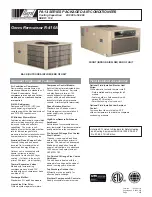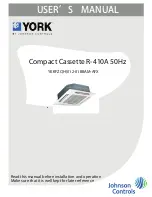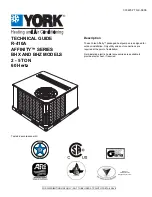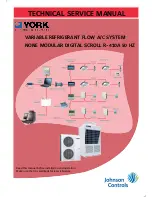
7 Electrical installation
Installation manual
7
FTXTA30C2V1B(W)(B)
Daikin room conditioner
3P697375-7H – 2023.09
NOTICE
The piping and other pressure-containing parts shall be
suitable for refrigerant. Use phosphoric acid deoxidised
seamless copper for refrigerant piping.
▪ Foreign materials inside pipes (including oils for fabrication) must
be ≤30 mg/10 m.
Refrigerant piping diameter
Use the same diameters as the connections on the outdoor units:
Liquid piping
Gas piping
Ø6.4 mm
Ø9.5 mm
Refrigerant piping material
▪
Piping material:
phosphoric acid deoxidised seamless copper
▪
Flare connections:
Only use annealed material.
▪
Piping temper grade and thickness:
Outer diameter
(Ø)
Temper grade
Thickness (t)
(a)
6.4 mm (1/4")
Annealed (O)
≥0.8 mm
t
Ø
9.5 mm (3/8")
Annealed (O)
(a)
Depending on the applicable legislation and the maximum
working pressure of the unit (see "PS High" on the unit name
plate), larger piping thickness might be required.
6.1.2
Refrigerant piping insulation
▪ Use polyethylene foam as insulation material:
▪ with a heat transfer rate between 0.041 and 0.052 W/mK (0.035
and 0.045 kcal/mh°C)
▪ with a heat resistance of at least 120°C
▪ Insulation thickness
Pipe outer diameter
(Ø
p
)
Insulation inner
diameter (Ø
i
)
Insulation thickness
(t)
6.4 mm (1/4")
8~10 mm
≥10 mm
9.5 mm (3/8")
12~15 mm
Ø
i
Ø
i
t
Ø
p
Ø
p
If the temperature is higher than 30°C and the humidity is higher
than RH 80%, the thickness of the insulation materials should be at
least 20 mm to prevent condensation on the surface of the
insulation.
6.2
Connecting the refrigerant piping
DANGER: RISK OF BURNING/SCALDING
6.2.1
To connect the refrigerant piping to the
indoor unit
WARNING: MILDLY FLAMMABLE MATERIAL
The refrigerant inside this unit is mildly flammable.
▪
Pipe length
. Keep refrigerant piping as short as possible.
1
Connect refrigerant piping to the unit using
flare connections
.
2
Wrap the refrigerant piping connection using vinyl tape,
overlapping at least half the width of the tape with each turn.
Keep the slit of the heat insulation pipe cover up. Avoid
wrapping the tape too tight.
b
a
c d
e
f
e
a
Heat insulation pipe cover (on the indoor unit side)
b
Flare connections
c
Liquid pipe (with insulation) (field supply)
d
Gas pipe (with insulation) (field supply)
e
Slit on heat insulation pipe cover facing up
f
Vinyl tape (field supply)
3
Insulate
the refrigerant piping, interconnection cable and drain
hose on the indoor unit: See
"8.1 To insulate the drain piping,
refrigerant piping and interconnection cable"
NOTICE
Make sure to insulate all refrigerant piping. Any exposed
piping might cause condensation.
6.2.2
To check refrigerant piping joints for leaks
after charging refrigerant
1
Perform the leak tests according to instructions in the outdoor
unit installation manual.
2
Charge refrigerant.
3
Check for refrigerant leaks after charging (see below).
Tightness test of field-made refrigerant joints indoors
1
Use a leakage test method with a minimum sensitivity of 5 g of
refrigerant/year. Test leaks using a pressure of at least 0.25
times the maximum working pressure (see "PS High" on the
unit nameplate).
If a leak is detected
1
Recover the refrigerant, repair the joint, and repeat the test.
7
Electrical installation
DANGER: RISK OF ELECTROCUTION
WARNING
ALWAYS use multicore cable for power supply cables.
WARNING
Use an all-pole disconnection type breaker with at least
3 mm between the contact point gaps that provides full
disconnection under overvoltage category III.
WARNING
If the supply cord is damaged, it MUST be replaced by the
manufacturer, its service agent or similarly qualified
persons in order to avoid a hazard.
WARNING
Do NOT connect the power supply to the indoor unit. This
could result in electrical shock or fire.






























